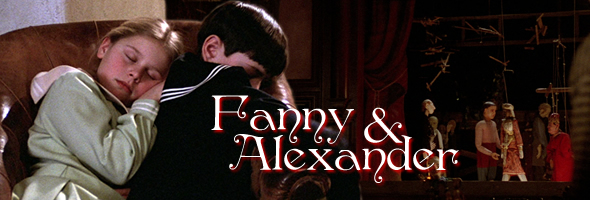
Color, 1982, 188m./312m.
Directed by Ingmar Bergman
Starring Pernilla Allwin, Bertil Guve, Börje Ahlstedt, Jan Malmsjö, Erland Josephson, Jan Malmsjö, Gunn Wallgren, Allan Edwall, Jarl Kulle, Ewa Fröling
Criterion (Blu-Ray & DVD) (US RA/R1 HD/NTSC), Artificial Eye (UK R2 PAL) / WS (1.66:1) (16:9)
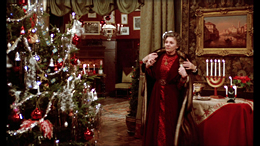 Touted upon its release as the cinematic swan song for internationally renowned director Ingmar Bergman (who proceeded to work for over a decade more in television and found a few sneaky ways to stay involved in feature films anyway), Fanny and Alexander remains one of the key films in the early ‘80s art house renaissance. While critics tended to look at it as a summing up of the director’s themes over the years, it also functions as a surprisingly modern and ambitious work of great complexity and visually ornate flourishes, along with some unexpected supernatural and gothic elements that make it an ideal introduction as well.
Touted upon its release as the cinematic swan song for internationally renowned director Ingmar Bergman (who proceeded to work for over a decade more in television and found a few sneaky ways to stay involved in feature films anyway), Fanny and Alexander remains one of the key films in the early ‘80s art house renaissance. While critics tended to look at it as a summing up of the director’s themes over the years, it also functions as a surprisingly modern and ambitious work of great complexity and visually ornate flourishes, along with some unexpected supernatural and gothic elements that make it an ideal introduction as well.
In the prologue we meet the titular Alexander (Guve), a young boy in the lavish Ekdahlska household prone to seeing ghosts, grim reapers, and moving statues. Then the elaborate opening act charts the family’s preparations and execution of 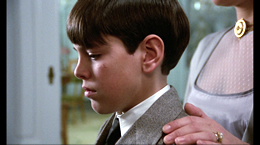 its Christmas festivities shortly after the turn of the 20th century, including a banquet and a nativity play. The lynchpin of the family is Helena, (Wallgren) whose three sons -- Gustav (Kulle), Carl (Ahlstedt), and Oscar (Edwall)-- are all married and have families, while Helena still has a very close relationship with Jewish art dealer Isak (Josephson). When Oscar dies while preparing fora production of Hamlet, his children must soon contend with their new stepfather, the domineering bishop Vergerus (Malmsjö), who keeps them imprisoned in his house. Through the intervention of sleight of hand and possibly magic, they soon have a chance at salvation as the structure of the family continues to evolve.
its Christmas festivities shortly after the turn of the 20th century, including a banquet and a nativity play. The lynchpin of the family is Helena, (Wallgren) whose three sons -- Gustav (Kulle), Carl (Ahlstedt), and Oscar (Edwall)-- are all married and have families, while Helena still has a very close relationship with Jewish art dealer Isak (Josephson). When Oscar dies while preparing fora production of Hamlet, his children must soon contend with their new stepfather, the domineering bishop Vergerus (Malmsjö), who keeps them imprisoned in his house. Through the intervention of sleight of hand and possibly magic, they soon have a chance at salvation as the structure of the family continues to evolve.
Immediately recognized as a classic upon its release and winner of four Oscars including Best Foreign Film, Fanny and Alexander has always had to contend with a common perception that, probably due to its daunting length, it's somehow a "homework" film that one has to slog through. That's hardly the case as, like many other Bergman films, it's an engrossing and often unpredictable experience with some touches of magic realism and lush beauty (thanks in no small part to his regular cinematographer, Sven Nykvist, who does wonders with the recurring play motif). Most of Bergman's regular players were unable to do this film (some by choice, some without their knowledge), but the cast still includes some surprising faces including Ahlstedt (most famous for I Am Curious, Yellow) and even a young Lena Olin.
Theatrical audiences first 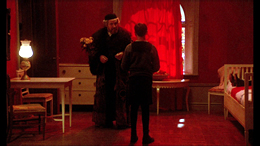 saw Fanny and Alexander in a version running slightly over three hours, and while this cut flows quite well and makes for a rewarding experience, word soon got out that Bergman had also prepared a much longer, five-part edition for Swedish television. This wasn't such an uncommon practice at the time, as the same treatment was afforded other titles ranging all the way from prestige projects like Das Boot and The Last Emperor to Yor, the Hunter from the Future (a film you'll never, ever see mentioned in an Ingmar Bergman review again). The TV cut made its American video debut courtesy of the Criterion DVD box set in 2004, which compiled both versions together along with a healthy heaping of supplements. The longer version improves on its big screen sibling in several respects, including a stronger emphasis on Alexander's perception of supernatural undercurrents in everyday life and much more detail on the family's holiday and theatrical production preparations. This isn't just a case of added footage, either, as many sequences are shuffled in a different order; even a survey of the opening half hour of both versions reveals a multitude of differences in the exit points of numerous scenes and the sequence in which they appear. If you have the time and really want a full, immersive experience, go for the TV cut; not only is it the richest option, but it includes several natural breaking points if you
saw Fanny and Alexander in a version running slightly over three hours, and while this cut flows quite well and makes for a rewarding experience, word soon got out that Bergman had also prepared a much longer, five-part edition for Swedish television. This wasn't such an uncommon practice at the time, as the same treatment was afforded other titles ranging all the way from prestige projects like Das Boot and The Last Emperor to Yor, the Hunter from the Future (a film you'll never, ever see mentioned in an Ingmar Bergman review again). The TV cut made its American video debut courtesy of the Criterion DVD box set in 2004, which compiled both versions together along with a healthy heaping of supplements. The longer version improves on its big screen sibling in several respects, including a stronger emphasis on Alexander's perception of supernatural undercurrents in everyday life and much more detail on the family's holiday and theatrical production preparations. This isn't just a case of added footage, either, as many sequences are shuffled in a different order; even a survey of the opening half hour of both versions reveals a multitude of differences in the exit points of numerous scenes and the sequence in which they appear. If you have the time and really want a full, immersive experience, go for the TV cut; not only is it the richest option, but it includes several natural breaking points if you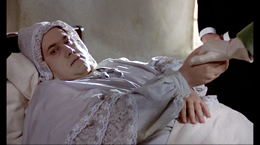 need to take a breather or split it over multiple days.
need to take a breather or split it over multiple days.
By contrast, the 2011 Blu-Ray edition from Criterion offers an appreciable demonstration of home video technology's advances over the course of a few years. The HD transfer here looks terrific throughout, with a richness and a tactile filmic quality that far outclasses the limitations of standard def predecessors. In particular, the frequent scenes filled with red color schemes look much more precise and legible than before, while the delicate textures of Nykvist's photography come through with admirable precision. Despite taking up far more disc space (both are on BD-50 discs), the television cut looks about the same as the theatrical one apart from some slightly sharper film grain for some reason. The lossless Swedish audio for both sounds fine and boasts optional English subtitles, while the theatrical cut also boasts the English dubbed track as an option. (It's not bad, actually.) The theatrical version (on disc two) also features the original trailer and carries over the terrific audio commentary by Bergman scholar Peter Cowie (a name familiar to many Criterion fans). He does a marvelous job of filling up the three hours with a deluge of facts about the films, many culled from his own interviews with the actors and crew members as well as some nice details about the film's sometimes significant embellishments on Bergman's unusual original screenplay, which took several years to write and bring to the screen. The third disc is devoted entirely to the remainder of the extras, with the centerpiece of the set still being the feature-length (109m.) documentary, The Making of Fanny and Alexander, in a new 1080p hi-def transfer. The other DVD extras are carried over in standard def including the lengthy "Ingmar Bergman Bids Farewell to Film" TV interview (shown two years after the film's completion), in which the director talks about his thoughts on his career and how he reached what felt like a natural stopping point, along with the 40-minute "A Bergman Tapestry" with many of the key personnel (Josephson, Frölin, and Guve, for example) from the film offering a later perspective on working on what would prove to be a major international masterpiece. Also included are costume sketches, a stills gallery, and a substanital insert booklet with essays about the film by Stig Björkman, Rick Moody, and Paul Arthur.
Reviewed on November 7, 2011.




 saw Fanny and Alexander in a version running slightly over three hours, and while this cut flows quite well and makes for a rewarding experience, word soon got out that Bergman had also prepared a much longer, five-part edition for Swedish television. This wasn't such an uncommon practice at the time, as the same treatment was afforded other titles ranging all the way from prestige projects like Das Boot and The Last Emperor to Yor, the Hunter from the Future (a film you'll never, ever see mentioned in an Ingmar Bergman review again). The TV cut made its American video debut courtesy of the Criterion DVD box set in 2004, which compiled both versions together along with a healthy heaping of supplements. The longer version improves on its big screen sibling in several respects, including a stronger emphasis on Alexander's perception of supernatural undercurrents in everyday life and much more detail on the family's holiday and theatrical production preparations. This isn't just a case of added footage, either, as many sequences are shuffled in a different order; even a survey of the opening half hour of both versions reveals a multitude of differences in the exit points of numerous scenes and the sequence in which they appear. If you have the time and really want a full, immersive experience, go for the TV cut; not only is it the richest option, but it includes several natural breaking points if you
saw Fanny and Alexander in a version running slightly over three hours, and while this cut flows quite well and makes for a rewarding experience, word soon got out that Bergman had also prepared a much longer, five-part edition for Swedish television. This wasn't such an uncommon practice at the time, as the same treatment was afforded other titles ranging all the way from prestige projects like Das Boot and The Last Emperor to Yor, the Hunter from the Future (a film you'll never, ever see mentioned in an Ingmar Bergman review again). The TV cut made its American video debut courtesy of the Criterion DVD box set in 2004, which compiled both versions together along with a healthy heaping of supplements. The longer version improves on its big screen sibling in several respects, including a stronger emphasis on Alexander's perception of supernatural undercurrents in everyday life and much more detail on the family's holiday and theatrical production preparations. This isn't just a case of added footage, either, as many sequences are shuffled in a different order; even a survey of the opening half hour of both versions reveals a multitude of differences in the exit points of numerous scenes and the sequence in which they appear. If you have the time and really want a full, immersive experience, go for the TV cut; not only is it the richest option, but it includes several natural breaking points if you need to take a breather or split it over multiple days.
need to take a breather or split it over multiple days.